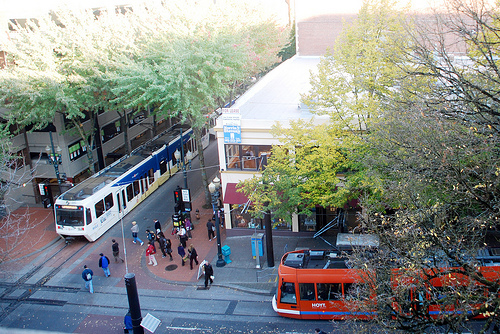Europe’s real streetcar lesson: Context matters
In the ongoing debate about where and when to build streetcars, the topic of whether they should run in mixed-traffic or dedicated lanes is a major point of contention. But outside the ivory tower of the blogosphere, it’s not an ideological question so much as a contextual one.
Virtually all transit advocates agree that both rail and buses run better when you give them a dedicated right of way. But since real life isn’t SimCity, cities only dedicate space to transit where the geographic and political context allows.
For most cities, that means dedicated transitways sometimes, and mixed-traffic others.
But Stephen Smith, who blogs at Next City and Market Urbanism, has made it a point to categorically attack mixed-traffic streetcars:
STOP. BUILDING. MIXED-TRAFFIC. CURB-RUNNING. STREETCARS
— Market Urbanism (@MarketUrbanism) October 31, 2013If primarily mixed-traffic streetcars are such a great idea, how come no other country on earth except the US is builds new ones?
— Market Urbanism (@MarketUrbanism) January 11, 2014
Smith admits that Europe does build mixed-traffic streetcars, but argues theirs usually have fewer and shorter mixed-traffic segments.
While the lines Malouff mentioned do at times travel in lanes with cars, these segments are, with one exception, very short.
That’s true. It’s because European cities are starting from a stronger transit context than most US cities. Many of them still run their original mixed-traffic trolley networks, so they don’t need to build those now. Meanwhile, with such convenient transit networks already in place, taking lanes from cars is more politically palatable.
Yet still, Stephen admits that European cities use mixed-traffic when the context is appropriate.
Of course that’s what they do. That’s what US cities do too. That’s what everyone does.
That’s why DC’s east-west streetcar runs in mixed-traffic on H Street but will have a dedicated transitway downtown, why Arlington’s streetcar runs in mixed-traffic on Columbia Pike but in a transitway in Potomac Yard, and why Seattle’s South Lake Union streetcar runs in mixed-traffic on Westlake Avenue but in a transitway on Valley Street.
Context is why Tacoma and Houston have transitway streetcars, while Tucson and Atlanta will have the exact same vehicle models running in mixed-traffic. It’s why Salt Lake City’s “light rail” sometimes runs in the street, while its “streetcar” runs in an old freight corridor. And it’s why Portland runs a mixed-traffic streetcar line and a dedicated-lane light rail one on perpendicular streets through the same intersection.
And it’s why half the cities in Europe run a combination of mixed and dedicated trams.
That isn’t an argument for or against mixed-traffic streetcars, nor for or against BRT, nor for or against anything. It’s an admission that everyone builds the best thing they can based on the circumstances of where they are, who they are, and what they’re trying to accomplish.
It’s an admission that context matters, and we all make decisions based on real world constraints and opportunities rather than black and white dogma.
Don’t use hypothetical perfects to ruin real life goods
Smith is right that every streetcar line in America that’s planned to run in mixed-traffic would be better if it had a transitway. Every one. In the places where dedicated lanes aren’t proposed, it’s totally appropriate to ask why not, and advocate for their inclusion. Transit advocates should absolutely be doing that.
But if we don’t get everything we want, we need not take our ball and go home. There are plenty of benefits to streetcars besides where they run, plenty of room for meaningful transit improvements even without a lane.
Sometimes there’s a good reason for running in mixed-traffic. Probably not as often as it actually happens, but sometimes. For example on Columbia Pike, where Arlington is prohibited from taking lanes.
Even if the only reason is political, as it seems to be in Cincinnati, some places face such a monumental uphill battle to get anything transit-related done, even a single mixed-traffic streetcar can raise regional transit ridership by almost 10%. That’s a huge victory in a place where holding out for something perfect would likely kill the project completely.
What transit advocates shouldn’t be doing is falsely claiming that nobody except misguided Americans builds streetcars. It’s not true and it’s not helpful. Broad brush attacks lead others to pen bogus anti-rail screeds with misleading information.
So by all means, let’s do more to fight for transitways. But in our attempts to do so, let’s not tear down the places that for whatever reason are merely capable of making good investments instead of perfect ones.
For the record, the same argument is true for BRT. Sometimes it’s the right answer, even though BRT creep, where costly transit features are stripped away to save money, is often a problem.
 Cross-posted at BeyondDC.
Cross-posted at BeyondDC.

